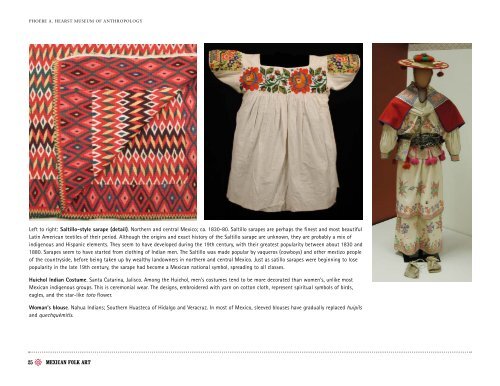Mexican Folk Art - Home
Mexican Folk Art - Home
Mexican Folk Art - Home
Create successful ePaper yourself
Turn your PDF publications into a flip-book with our unique Google optimized e-Paper software.
PHOEBE A. HEARST MUSEUM OF ANTHROPOLOGY<br />
Left to right: Saltillo-style sarape (detail). Northern and central Mexico; ca. 1830-80. Saltillo sarapes are perhaps the finest and most beautiful<br />
Latin American textiles of their period. Although the origins and exact history of the Saltillo sarape are unknown, they are probably a mix of<br />
indigenous and Hispanic elements. They seem to have developed during the 19th century, with their greatest popularity between about 1830 and<br />
1880. Sarapes seem to have started from clothing of Indian men. The Saltillo was made popular by vaqueros (cowboys) and other mestizo people<br />
of the countryside, before being taken up by wealthy landowners in northern and central Mexico. Just as satillo sarapes were beginning to lose<br />
popularity in the late 19th century, the sarape had become a <strong>Mexican</strong> national symbol, spreading to all classes.<br />
Huichol Indian Costume. Santa Catarina, Jalisco. Among the Huichol, men's costumes tend to be more decorated than women's, unlike most<br />
<strong>Mexican</strong> indigenous groups. This is ceremonial wear. The designs, embroidered with yarn on cotton cloth, represent spiritual symbols of birds,<br />
eagles, and the star-like toto flower.<br />
Woman's blouse. Nahua Indians; Southern Huasteca of Hidalgo and Veracruz. In most of Mexico, sleeved blouses have gradually replaced huipils<br />
and quechquémitls.<br />
25 � MEXICAN FOLK ART


